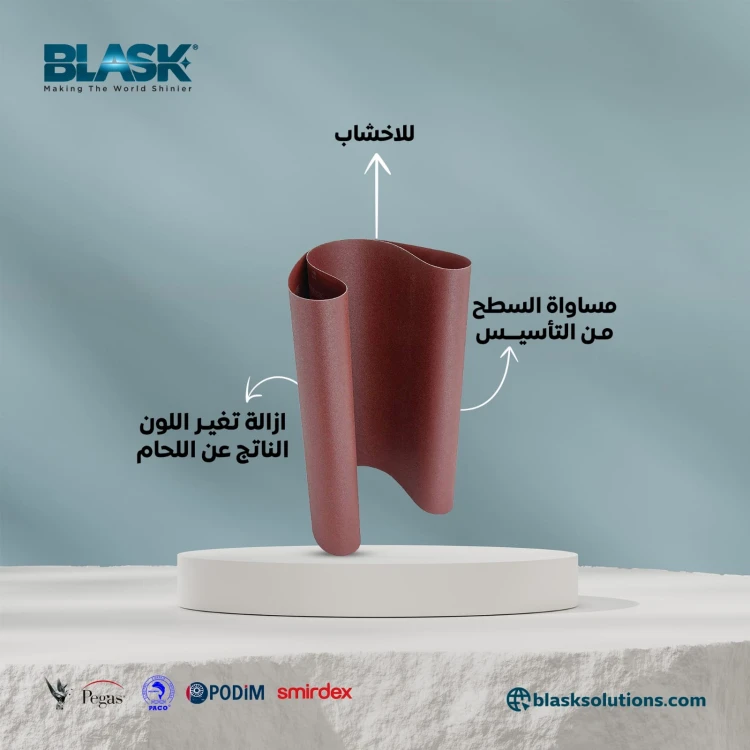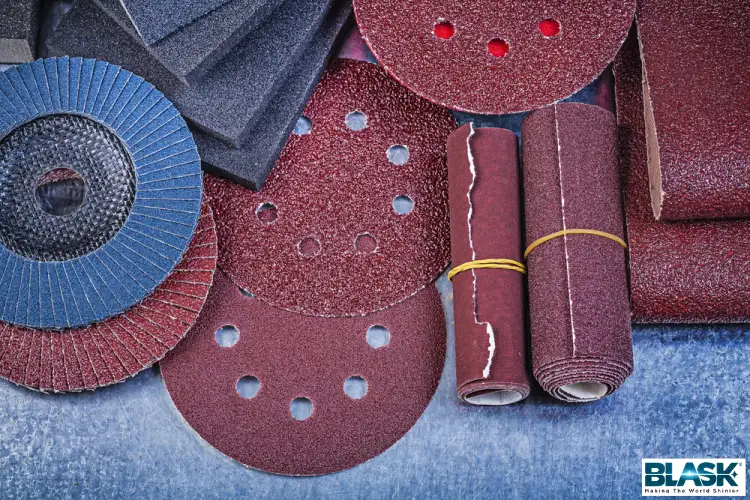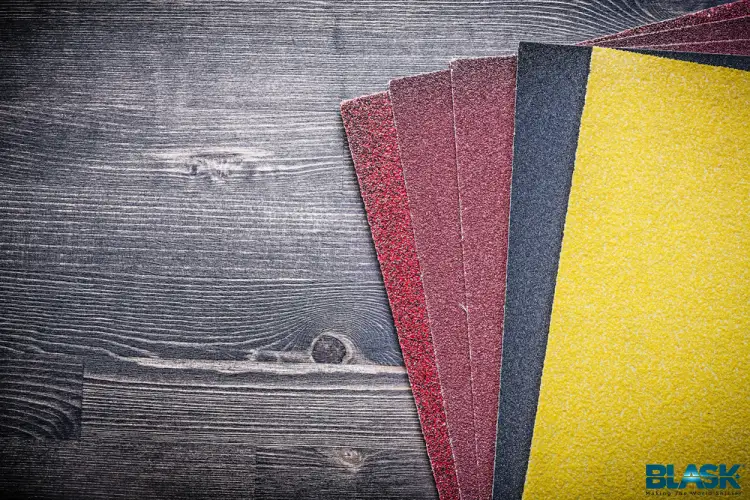Wall sandpaper is considered one of the basic tools used in preparing and finishing surfaces and walls to complete the staining and painting process. The sandpaper works to make the wall even and have a smooth texture, which contributes to increasing the strength of the paint’s adhesion to the wall and gives it an attractive aesthetic appearance.
The types of wall sandpaper vary according to the size of the grains used in each sheet, and the extent of its quality also varies according to the brand it is made of. Therefore, Blask Solutions provides the best types and brands for its customers to ensure the quality of the paper’s performance and its use for a longer period.
What is wood sanding?
Wood sanding is a very important process, as the craftsman uses different abrasive materials to prepare and smooth the wooden surfaces, in order to shape the wood and use it in making furniture or renewing it by scraping off the old layer. The wood sanding process is done using several materials, each of which has specific characteristics and applications, as the materials vary. Used in sanding wood to:
- Aluminum oxide: Suitable for sanding wood and metal and is commonly used in wood sanding.
- Silicon carbide: It is harder than aluminum oxide so is commonly used with very hard materials.
- Agate: It is a natural mineral material that is used as an abrasive. It is considered softer than aluminum oxide and silicon carbide, so it is commonly used in the final finishing of wood surfaces.
- Ceramic: It is used for heavy sanding tasks due to its high ability to withstand pressure.
Sandpaper sizes

The sizes of sandpaper for walls and other hard surfaces depend on understanding the sizes of the grains used in manufacturing and shaping the sandpaper, as sandpaper varies depending on the size of the abrasive particles as follows:
- Coarse grains (40 – 60): This size is used to remove old paint, or rough wood, so it is ideal for heavy sanding and shaping.
- 120 sandpaper (Medium grits) (80 – 120):These are suitable for initial sanding operations.
- 150 sandpaper (150 – 180): They are used in final sanding operations, before finishing.
- Very fine grains (220 – 240):This type of grit is ideal for sanding between layers of paint or varnish.
- Ultra fine grits (more than 400): They are mainly used for metal polishing and very fine sanding tasks.
How to use sandpaper
The good use of sandpaper greatly affects the final results of any sanding process, so you must know the correct steps for how to use it, which are done as follows:
1. Preparing the sanding process
This process is carried out by preparing the materials necessary to complete the sanding, as the following must be provided:
- Suitable sandpaper.
- Safety glasses.
- A clean piece of cloth.
- Dust collecting material.
2. Choose suitable sandpaper for each stage
Due to the presence of many types of wall sandpaper during the sanding process You should start with coarse-grit sandpaper to remove the rough material, then move on to using medium-grit sandpaper to complete the initial sanding process, then finish with fine-grit sandpaper to complete the final finishing job.
3. Use a sanding block or electric sander
This step takes place in two stages:
- Use of sanding block: This is done by wrapping the sandpaper around the sanding block to ensure that the pressure is evenly distributed.
- Electric sander: Where a sanding machine is used to complete the sanding process.
4. Choosing the sanding direction:
Choose direction Appropriate sanding with the surface is very important in order to avoid scratches that are difficult to remove.
5. Clean the surface regularly
Wipe the surface periodically with a clean cloth to remove dust, determine your progress, and keep the sandpaper from clogging.
6. Gradual use of granules
Start sanding with coarse grit and then gradually move to fine grit.
7. Final finishing
Use fine grit (220 – 240) to obtain a smooth surface ready for finishing.
8. Final cleaning
After completing the sanding, use a vacuum cleaner or a wet cloth to remove all dust before starting to paint or stain.
Types of wall sanding

The process of sanding walls is very important to achieve a perfect finish and make the walls smooth for the painting process. The types of wall sanding vary depending on the type of materials used in the sanding process and its purpose, as they include all of the following:
1.Wall sandpaper
Different types of sandpaper are used in the process of sanding and preparing the walls before starting to paint them.
2. Sand the mesh
It is commonly used in sanding drywall (gypsum board) and is characterized by allowing dust to pass through it, which reduces the chances of clogging and makes it last for longer periods.
3. Electric wall sander
They are used in different ways and mechanisms, as they contribute to obtaining a shiny surface at high speed.
4. Hand sanding
It is characterized by its precision, as sanding blocks are used with wall sandpaper and used manually to achieve better results.
Wall sanding steps
Care must be taken in the gradual steps of sanding walls, as each step affects the success of the process that follows. Below are the steps for sanding walls in detail:
1. Prepare and collect materials
Where special sanding materials are used for walls, care must be taken in choosing them. The Blask solutions store is considered one of the best online stores that provide sanding and finishing materials of various types, where you can shop for all of the following:
- Wall sandpaper of various types.
- Wall and ceiling sanding machine.
- Wall sanding missile.
- Dust collection system.
2. Preparing the place
Floors and furniture must be protected before starting the sanding process to protect them from dust, and care must be taken to open windows and doors to provide good ventilation for the place.
3. Choose suitable sandpaper
This is to remove impurities or old paint, then progress through the initial sanding process to reach the final stage of the sanding process.
4. Use an electric sander and a sanding block
This is to remove as much of the old layer or excesses accumulated on the surface.
5. Clean the surface regularly
Use a vacuum cleaner or cloth to determine the quality of the sanding process and check its progress.
6. Final sanding
It is done using fine wall sandpaper to ensure that the surface is even and smooth to the touch.
7. Preparing the wall for painting
This is done by ensuring that the wall is clean and dry before starting to paint.
Sandpaper

Sandpaper is a strong and flexible material covered with an abrasive material, which varies from one type to another. Sandpaper is used for many purposes, including handicrafts and arts, including wood and metal works. It is also used for construction and finishing purposes, so there are several types that differ in their characteristics and importance, as The uses of sandpaper vary as follows:
- Removing old paint: Using coarse grit to remove old paint and stuck-on particles.
- Surface smoothing: Medium-grit sandpaper is used to smooth wood surfaces and prepare them for painting.
- Metal surface finishing: Several types of sandpaper are used to finish various types of metal surfaces, especially those used in the automobile industry.
- Sanding between layers of paint: Very fine sandpaper is used to improve the adhesion of the new paint.
Where to buy sandpaper?
Sandpaper is used in a variety of fields so it is widespread Wall sandpaper In many places due to the increased demand for it, here are some places where you can get different sanding materials:
- Major commercial markets.
- Hand tool and equipment stores where they are commonly used by technicians and craftsmen.
- Specialized electronic stores, such as Blask Solutions, are one of the best stores specialized in selling all sanding and finishing materials.
- Industrial workshops and some small specialized shops.
Many important considerations must be taken into account when purchasing wall sandpaper and other types, including:
- Find out how good the sandpaper is.
- Look for reliable brands that offer high-quality products.
- Make sure to choose the right size of tools used in the sanding process.
- Take care to choose the appropriate paper for the type of surface to be sanded.
Get all your needs to complete the sanding and finishing process by visiting the blask solutions store, which provides an excellent collection of various sanding materials made with high quality from international brands.
Read more about: sand paper
Frequently asked questions
Should I sand the wall before painting?
The process of sanding the wall before painting is a very important process, as it contributes greatly to improving the quality of the appearance and color of the paint.






